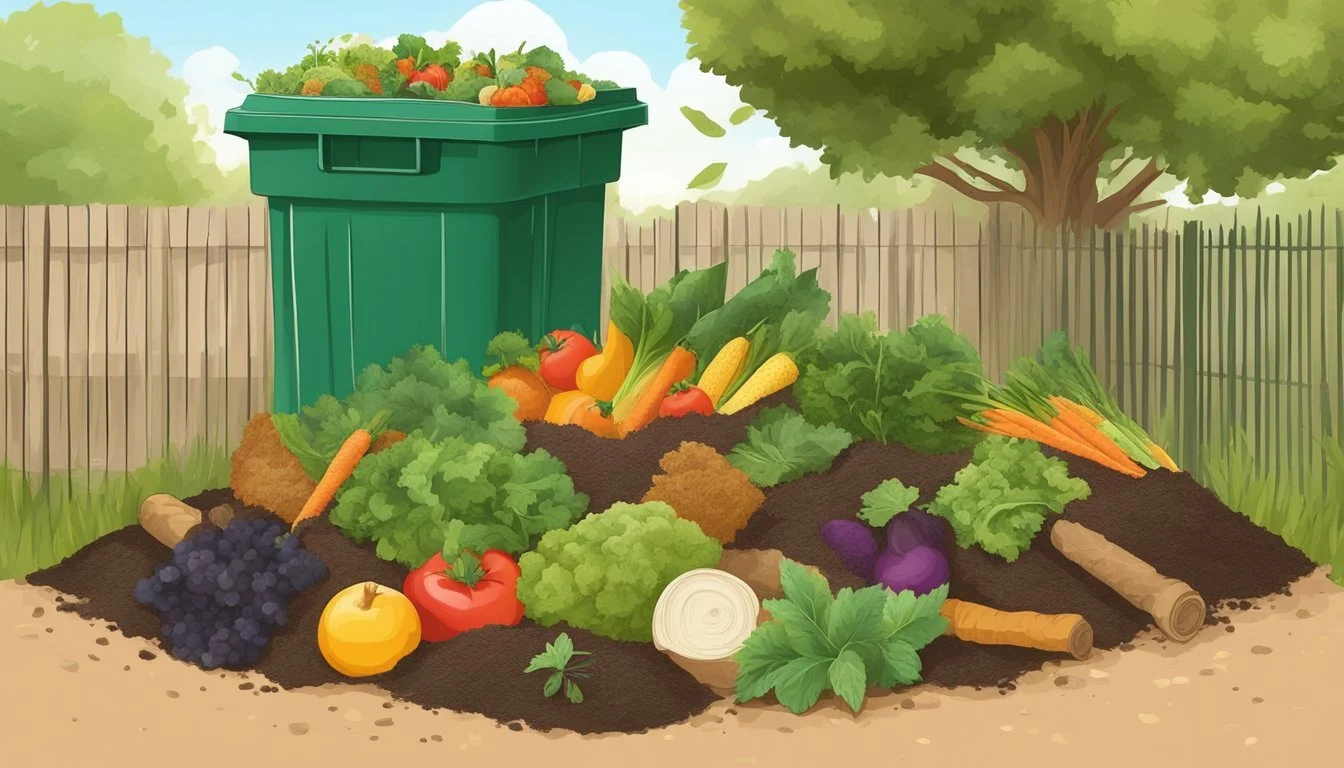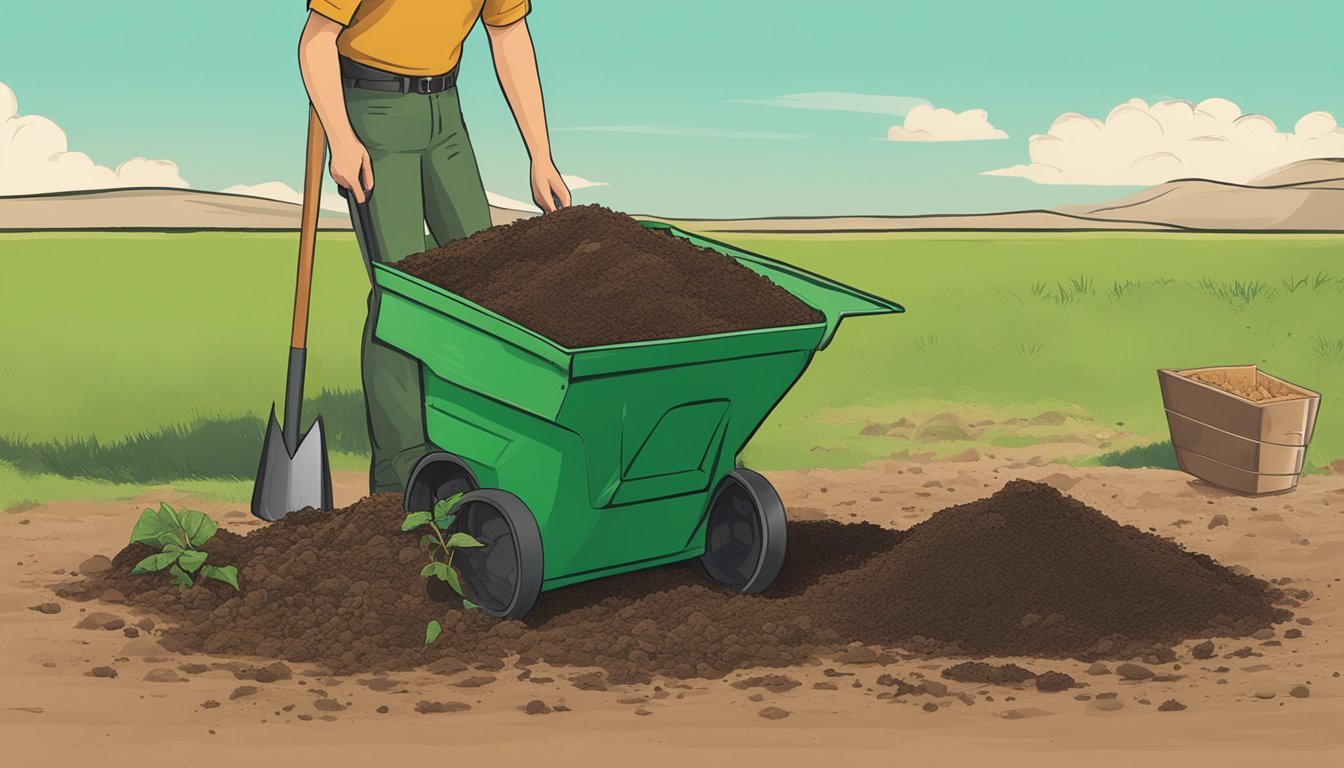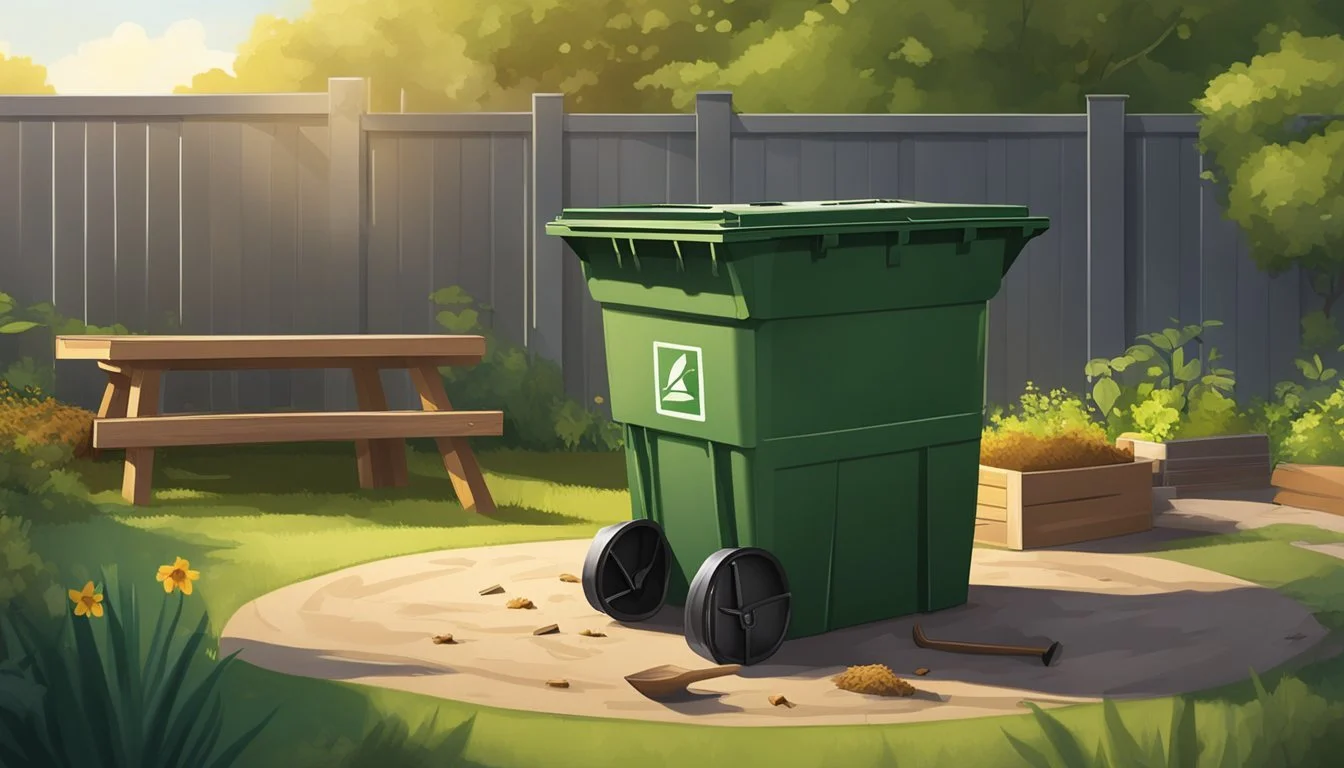Guide to Composting in Odessa, TX
Essential Tips for Successful Soil Enrichment
Composting in Odessa, TX offers residents a practical way to enrich their garden soil while reducing waste. Through the simple process of composting, organic material such as yard waste and kitchen scraps can be transformed into nutritious humus. This not only feeds gardens but also minimizes the environmental impact by reducing the amount of waste that ends up in landfills. Odessa's climate and community resources provide an excellent backdrop for those looking to start composting at home.
In Odessa, selecting the right location for a compost setup is crucial. A shaded area can prevent the compost from drying out too quickly, helping maintain the necessary moisture levels for effective decomposition. By composting, homeowners convert leaves, food waste, and other biodegradable items into valuable compost, which can considerably improve soil quality and plant health. The city encourages this practice as an easy and beneficial step towards sustainable living.
The composting process in Odessa involves balancing green waste, such as vegetable scraps and coffee grounds, with brown waste, like dried leaves and branches, to create an optimal environment for organic degradation. Proper moisture, aeration, and a balance of materials help expedite the composting process, allowing nature to recycle nutrients back into the soil. This supports healthier gardens and ecosystems throughout the Odessa community.
Basics of Composting
In Odessa, composting offers an effective way to convert kitchen scraps and yard waste into a valuable soil amendment, enriching the soil with nutrients as organic matter decomposes.
What Is Composting?
Composting is the natural process of recycling decomposing organic material such as leaves, vegetable scraps, and grass clippings into a rich soil conditioner known as compost. It serves not only as a fertilizer but also as a soil amendment, improving soil structure, aeration, and water retention.
Benefits of Composting
Composting provides multiple advantages to both the environment and gardeners. It turns waste that would otherwise end up in landfills into a resourceful product for gardening, thereby reducing methane emissions—a potent greenhouse gas. Furthermore, it enhances soil quality by adding essential nutrients that plants need to thrive.
List of composting benefits:
Reduces waste: Decreases the amount of organic material sent to landfills.
Improves soil health: Introduces beneficial organisms that help aerate the soil.
Conserves water: Helps soil retain moisture, reducing the need for irrigation.
Provides nutrients: Slowly releases nutrients which are less likely to run off than synthetic fertilizers.
Composting Myths Debunked
Several misconceptions surround the practice of composting, often deterring individuals from starting their own compost piles.
Myth 1: Composting is too complicated.
Truth: While there are best practices for optimal results, simply piling up yard waste and kitchen scraps will naturally decompose over time.
Myth 2: Composting attracts pests and smells bad.
Truth: A well-maintained compost pile that has a balance of green and brown materials will not emit foul odors and can be managed to deter pests effectively.
By understanding these basics, residents in Odessa can effectively transform what would be waste into a precious component of their gardens, thereby fostering a more sustainable lifestyle.
Setting Up Your Compost Area
Setting up a compost area requires careful consideration of location, the type of compost bin needed, and whether to purchase or build a bin. Each decision impacts the effectiveness of a composting system.
Choosing the Right Location
Selecting an appropriate location within your backyard is crucial for an efficient composting system. One must consider factors such as:
Access: The site should be easily reachable for adding materials and retrieving compost.
Sunlight: A balance is essential. Opt for a partially shaded area to avoid excessive drying while maintaining adequate warmth for decomposition.
Types of Compost Bins
Compost bins come in different styles, each suitable for various space constraints and needs:
Open Bins: Suitable for larger yards; they offer easy access but can attract wildlife.
Tumblers: Great for small spaces; they are enclosed and pest-resistant and allow for easy turning of compost.
DIY Compost Bins
Crafting your own compost bin can be economical and tailored to fit specific space requirements. Materials often used include:
Wood: Natural and sturdy, but requires routine maintenance.
Wire mesh: Inexpensive and easy to construct, ideal for temporary or seasonal use.
When setting up a composting system, ensure it suits the household's waste output and the backyard environment for a productive composting experience.
Composting Ingredients
Understanding the right ingredients for composting and their proper balance is essential for a successful composting process in Odessa, TX. It involves mixing 'greens', which are rich in nitrogen, with 'browns', which are high in carbon.
Greens and Browns
In the composting world, 'greens' refer to nitrogen-rich materials such as kitchen scraps, vegetable scraps, grass clippings, and coffee grounds. These materials are quick to decompose and provide the necessary proteins and amino acids for compost microorganisms. 'Browns' are carbon-rich materials including leaves, twigs, shredded newspaper, and branches. They add structure to the compost pile, allowing air to flow and encouraging the growth of fungi, which breaks down tough fibres.
Items to Compost
When composting in Odessa, citizens have a variety of organic waste they can contribute to their compost:
Greens:
Fruit and vegetable scraps
Coffee grounds and filters
Fresh grass clippings
Plant trimmings
Browns:
Autumn leaves
Twigs and branches, chopped or shredded
Eggshells, crushed
Shredded newspaper (avoid colored ink)
Each ingredient brings balance, helping to create nutrient-rich humus that will greatly benefit garden soils.
Items to Avoid
Not all organic waste is suitable for a compost pile, especially in a residential setting. Here are items that one should not include in their compost in Odessa:
Cooked food, dairy, and meat scraps as they can attract pests.
Diseased plant material, which could spread pathogens to the compost.
Dog, cat, or human waste, which can contain harmful bacteria or parasites.
Treated wood and yard trimmings, which may contain chemicals.
Maintaining Your Compost
Maintaining a compost pile requires careful monitoring and management of materials and environmental conditions. The goal is to foster an efficient decomposition process, which is essential for producing rich and nutritious compost for gardening use.
Balancing Green and Brown Materials
The compost pile should have a balanced mix of green materials, which provide nitrogen, and brown materials, which supply carbon. A general guideline is to aim for a carbon-to-nitrogen ratio of 30:1. Green materials include kitchen scraps and grass clippings, while brown materials consist of dry leaves, straw, or shredded newspaper. This balance is crucial for the microbes breaking down the waste to function optimally.
Green materials (Nitrogen-rich): grass clippings, vegetable scraps
Brown materials (Carbon-rich): dry leaves, twigs, paper
Moisture and Aeration
For microbes to thrive and decompose organic matter, the compost pile needs the right level of moisture and aeration. The moisture content should be akin to a damp sponge; it should feel moist but not soggy. To ensure proper aeration, one should periodically turn the pile to introduce air and prevent anaerobic conditions, which can slow down decomposition and cause foul odors.
Ideal moisture: similar to a wrung-out sponge
Aeration method: turn the pile or insert perforated pipes
Temperature and Turning
Temperature is a good indicator of composting activity. As microbes break down materials, heat is generated, causing the pile's temperature to rise. A properly maintained compost pile typically reaches temperatures between 130°F and 150°F. Regularly turning the compost helps maintain an even temperature throughout the pile and accelerates the breakdown of materials. It also ensures that materials from the edges are brought to the center, where it's hotter, enhancing the overall composting process.
Optimal temperature range: 130°F - 150°F
Turning frequency: every 4-6 weeks or when the temperature drops
Troubleshooting Common Issues
In composting, managing odors, preventing pests, and ensuring proper decomposition are crucial for a successful process. These issues can arise from imbalances in the microorganisms, oxygen levels, and materials within your compost pile.
Odor Management
Odor is a common issue in composting that indicates a potential imbalance. A rotten egg smell is often the result of anaerobic conditions, suggesting that the pile is too wet or compacted, which restricts oxygen flow. To rectify this, introduce dry, bulky materials like straw or leaves to absorb excess moisture and add structure to the pile, facilitating better oxygen circulation. Conversely, an ammonia odor suggests an excess of nitrogen-rich materials. Balancing with carbon-rich materials like cardboard or sawdust can neutralize the smell.
Pest Prevention
Pests may be attracted to the compost pile if food scraps are readily accessible or if there is not enough covering material. To prevent infestations, they should:
Ensure the compost is covered with a thick layer of carbon-rich materials.
Avoid adding meat, dairy, or oily foods that attract rodents and flies.
Maintain a good balance of green and brown materials to promote a hot composting environment which is less inviting to pests.
Compost Not Decomposing
When compost is not decomposing efficiently, it could be due to several factors:
Temperature: The pile may not be hot enough, indicating a lack of microorganisms or an imbalance in materials.
Moisture: Too little water hampers microbial activity, while too much can lead to anaerobic conditions.
Aeration: Turning the pile regularly to introduce oxygen is crucial for breakdown.
By monitoring and adjusting the balance of greens, browns, moisture, and aeration, one can ensure that microorganisms can effectively break down organic matter into compost.
Vermicomposting
Vermicomposting harnesses the natural process where earthworms transform decomposed materials into a nutrient-rich compost. It is a suitable method for Odessa, TX residents to manage organic waste and enhance soil fertility effectively.
Understanding Vermicomposting
Vermicomposting is the practice of using worms to break down organic waste, thereby converting it into a nutrient-rich by-product known as worm castings or vermicompost. This method relies on red wigglers or earthworms to digest decomposed material in a controlled environment. The main benefits of vermicomposting include the production of a high-quality, natural fertilizer that enriches soil and supports plant growth.
Setting Up a Worm Bin
Starting a worm bin requires a few key steps. First, one must choose an appropriate container; this can be a purchased compost bin or a DIY system. The container size should fit the amount of waste produced and typically has a set of guidelines, such as those detailed in the Ultimate Guide to Starting a Worm Composting Bin for Beginners. Next, create a bedding of moistened shredded newspaper or cardboard, ensuring the environment is damp but not waterlogged.
Worm Care and Maintenance
Once the worm bin is in place, maintaining a thriving vermicomposting system involves regularly feeding the worms and monitoring moisture levels. Worms feed on organic kitchen scraps—fruits, vegetables, coffee grounds, and eggshells—but should not be given meats or dairy products. The bin should be kept in a location out of direct sunlight with temperatures between 55-77°F, which, according to an article on Red Worm Composting, is suitable for outdoor worm bins in Texas with some consideration for shade and insulation. Regularly harvesting the compost and replenishing the bin will keep the worms healthy and productive.
Using Your Finished Compost
Once your compost has transformed into a dark, crumbly mixture with an earthy odor, it is ready to enrich your garden and support plant growth as a powerful soil amendment.
When is Compost Ready?
Finished compost, also known as humus, is achieved after a concoction of organic materials has adequately broken down. You'll know it's complete when the material is dark, no longer emits an offensive odor, and you can't distinguish the original ingredients. The compost should also be cool, indicating that the microbial activity has slowed down. This nutrient-rich end product is essential for enhancing garden soil and revitalizing your plants.
Applying Compost to Your Garden
To use compost as a soil conditioner in your garden, integrate it into the topsoil by laying a 2- to 3-inch layer of finished compost and working it into the top 6 inches of soil. For potted plants or raised beds, you can mix it directly with the potting soil or topsoil to create a nutrient-rich growing medium. When used as mulch, a layer spread around plants can help retain soil moisture and suppress weeds.
Other Uses for Compost
Aside from traditional garden applications, finished compost is versatile:
Lawn care: A thin layer of compost spread over a lawn can serve as a natural fertilizer, promoting lush, green growth.
Soil remediation: Compost can improve soil structure, helping sandy soils retain moisture and helping clay soils drain better.
Composting tea: Steeping compost in water produces a nutrient-rich liquid that can be used for watering plants, soaking seeds, or giving seedlings a boost.
Community and Beyond
The implementation of composting practices has significant implications for Ector County's sustainability goals, aiming to reduce waste in landfills and foster community engagement through shared garden spaces and educational initiatives.
Composting in Ector County
Ector County has embraced composting as a means to divert yard debris and organic waste from landfills, thereby extending landfill lifespans. The Texas A&M County Extension Office in Ector County provides valuable resources and education on composting techniques that can transform everyday waste into valuable compost for gardening and landscaping.
Community Gardens and Composting
Community gardens in Odessa serve not only as spaces to cultivate plants but also as hubs for composting activities. These gardens encourage residents to contribute organic waste which, in turn, provides nutrient-rich soil amendments that benefit the entire community. By educating participants on composting, these gardens foster a culture of environmental stewardship.
Composting and Local Legislation
Local legislation in Ector County reflects a commitment to environmental responsibility, including measures that support and sometimes even mandate composting practices. Such legislation often aims to reduce the burden on area landfills and promote sustainable waste management practices across Ector Counties.
Resources and Learning
In Odessa, Texas, residents eager to embark on composting have access to a variety of resources tailored to educate and guide them through the process. From expert-led workshops to a wealth of educational materials, the community provides numerous opportunities for individuals to learn and stay up-to-date with composting practices.
Composting Workshops
Keep Midland Beautiful offers composting workshops catering to both beginners and seasoned composters. These workshops focus on methods to turn organic waste into nutrient-rich soil, equipping participants with the know-how to start and maintain a successful composting system. Details and registration for upcoming workshops are regularly updated on their website.
Educational Materials
A plethora of educational materials is available for those looking to grow their knowledge of composting. The Odessa American provides articles on different composting techniques and tips for a happy gardening experience. Furthermore, comprehensive guides and videos can be found online, which are particularly beneficial for visual learners.
Staying Informed
For continuous learning, interested individuals can subscribe to a newsletter that offers monthly insights and news on composting in the area. Staying informed is as easy as providing an email address to local gardening groups or environmental organizations. They deliver timely information, seasonal tips, and encouragement straight to one's inbox, ensuring the community remains knowledgeable about sustainable practices.










